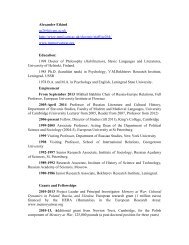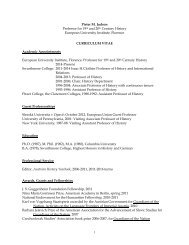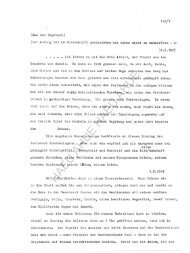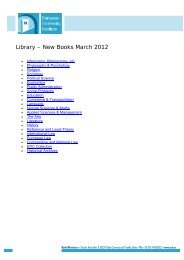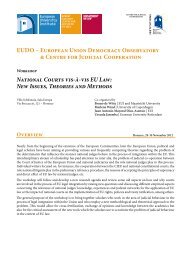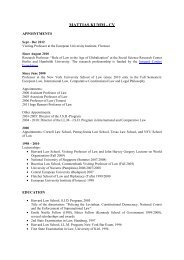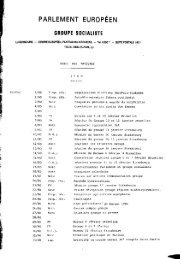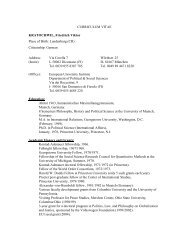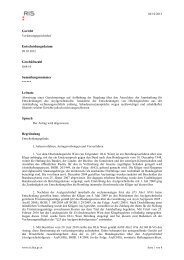Do labor market institutions matter for business cycles?∗ - European ...
Do labor market institutions matter for business cycles?∗ - European ...
Do labor market institutions matter for business cycles?∗ - European ...
Create successful ePaper yourself
Turn your PDF publications into a flip-book with our unique Google optimized e-Paper software.
4 LABOR MARKETS REFORMS AND BUSINESS CYCLES 14<br />
ratio <br />
CA<br />
Y , between 1995 and 2009 <strong>for</strong> the control and treated groups presented in Table 8 12 .<br />
Clearly, the hypothesis that the treated and the control groups are significantly different can<br />
be rejected <strong>for</strong> any pair and any characteristic we examine at the 5% level of confidence.<br />
The identifying assumption could also be violated if re<strong>for</strong>ms are not random and whatever<br />
triggers the re<strong>for</strong>m also has a causal effect on <strong>business</strong> <strong>cycles</strong>; <strong>for</strong> instance, <strong>labor</strong> <strong>market</strong>s<br />
re<strong>for</strong>ms might be systematically enacted during deep recessions, since it is easier to convince<br />
the public of the necessity of such re<strong>for</strong>ms in bad times. As it is standard, we control <strong>for</strong> the<br />
potential endogeneity problems by including the initial condition as a regressor.<br />
Implementing our estimation strategy requires care on a few other issues. First, some<br />
re<strong>for</strong>ms take place very close to the end of the sample. Because the dependent variable<br />
measuring post-re<strong>for</strong>m <strong>business</strong> cycle statistics spans a quite short time series we do not<br />
study the effects of such re<strong>for</strong>ms. Second, an additional problem stems from the observation<br />
that <strong>labor</strong> <strong>market</strong> re<strong>for</strong>ms may have not been independent from each other. As a result, if<br />
two re<strong>for</strong>ms are undertaken simultaneously, the omission of one treatment may lead to bias<br />
in the estimated effect of the included one. For that reason we exclude from the sample<br />
countries that have enacted a number of <strong>labor</strong> <strong>market</strong> re<strong>for</strong>ms simultaneously.<br />
We proceed as follows: First, after identifying the dates when changes have taken place <strong>for</strong><br />
each country, we divide countries in two groups. In the treatment group we include countries<br />
where <strong>labor</strong> <strong>market</strong> re<strong>for</strong>ms have been passed. We classify as belonging to the control group<br />
all countries <strong>for</strong> which we have data and that did not implement any re<strong>for</strong>m. Second the<br />
sample is split into two sub-samples, the pre-re<strong>for</strong>m period and the post-re<strong>for</strong>m period, and<br />
we examine whether the relation between LMI and <strong>business</strong> <strong>cycles</strong> have changed in re<strong>for</strong>mers<br />
relative to non-re<strong>for</strong>mers. For the non-re<strong>for</strong>mers the pre and post re<strong>for</strong>m samples are split<br />
using the average date of re<strong>for</strong>ms in the treated group. So, <strong>for</strong> example, <strong>for</strong> EPL, re<strong>for</strong>ms<br />
have taken place in Sweden in 1993:4, and in Finland, Italy and Portugal in 1990:4, so that<br />
<strong>for</strong> the control group the pre re<strong>for</strong>m sample finishes in 1991:4 and the post re<strong>for</strong>m samples<br />
starts in 1992:1. When more than one wave of re<strong>for</strong>ms exists, we repeat the procedure <strong>for</strong><br />
each wave in such a way that the post-re<strong>for</strong>m period of a particular regulatory change does<br />
not overlap with the post-re<strong>for</strong>m period of the subsequent one. For example, in the case of<br />
employment protection, re<strong>for</strong>ms took place in Spain both in 1984 and 2002. In 1984 there<br />
have been re<strong>for</strong>ms that encouraged part-time work, while the 2002 re<strong>for</strong>m eased dismissal.<br />
To avoid overlapping samples, when testing the 2002 change we exclude the period be<strong>for</strong>e<br />
1984. To allow <strong>for</strong> delays in the effects of re<strong>for</strong>ms, we leave one year out of the post-re<strong>for</strong>m<br />
sample. We select the post-re<strong>for</strong>m periods <strong>for</strong> countries in the control group using the mean<br />
start date <strong>for</strong> the countries in the treatment group.<br />
The empirical model is:<br />
12 Results <strong>for</strong> earlier averages are similar but we have less time series available to control <strong>for</strong> different<br />
characteristics.



